Abstract
The selective catalytic reduction (SCR) is the most commonly used technique for decreasing the emissions of nitrogen oxides (NOx) from heavy-duty diesel vehicles (HDDVs). However, the same injection strategy in the SCR system shows significant variations in NOx emissions even at the same operating mode. This kind of heterogeneity poses challenges to the development of emission inventories and to the assessment of emission reductions. Existing studies indicate that these differences are related to the exhaust temperature. In this study, an emission model is established for different source types of HDDVs based on the real-time data of operating modes. Firstly, the initial NOx emission rates (ERs) model is established using the field vehicle emission data. Secondly, a temperature model of the vehicle exhaust based on the vehicle specific power (VSP) and the heat loss coefficient is established by analyzing the influencing factors of the NOx conversion efficiency. Thirdly, the models of NOx emissions and the urea consumption are developed based on the chemical reaction in the SCR system. Finally, the NOx emissions are compared with the real-world emissions and the estimations by the proposed model and the Motor Vehicle Emission Simulator (MOVES). This indicates that the relative error by the proposed method is 12.5% lower than those calculated by MOVES. The characteristics of NOx emissions under different operating modes are analyzed through the proposed model. The results indicate that the NOx conversion rate of heavy-duty diesel trucks (HDDTs) is 39.2% higher than that of urban diesel transit buses (UDTBs).
1. Introduction
The oxides of nitrogen (NOx) emitted from heavy-duty diesel engines are considered to be important sources of atmospheric pollution [1]. A urea-selective catalytic reduction (SCR) system is used to reduce the NOx emissions from heavy-duty diesel engines [2] by injecting urea at a sufficiently high exhaust temperature (generally at 200 °C) [3]. At present, the urea injection strategy of the SCR system for heavy-duty diesel vehicles (HDDVs) is designed based on the European transient cycle (ETC) and the European steady-state cycle (ESC). However, for different source types of vehicles equipped with the same engine and SCR system, the operating modes could be significantly different [4,5,6,7]. As shown in Figure 1 (the data is the field operational data of Beijing heavy-duty buses and heavy-duty trucks collected in 2018 using GPS), urban transit buses frequently operate at a lower speed range than heavy-duty trucks, while heavy-duty trucks run fairly smoothly at a high-speed range.

Figure 1.
Field trajectories of an urban transit bus and a heavy-duty truck.
The differences in operating modes for different source types of HDDVs result in the uncertainty of the emissions estimations. For the HDDVs equipped with SCR systems, the NOx emissions are affected by the temperature of the exhaust gas [8]. Even for the same operating speed or vehicle specific power (VSP), there is a significant variation in NOx emissions caused by the different exhaust gas temperatures. However, current studies about NOx emission estimations do not consider the temperature of the exhaust gas, and the emission rates are directly calculated using the field data, which leads to an inaccuracy of the emissions measurement.
In order to accurately calculate NOx emissions of HDDVs, it is necessary to understand the working mechanism of the SCR system. For HDDVs, the preferred reductant is typically an aqueous solution of nontoxic urea, which is decomposed to ammonia (NH3) to convert the NOx to nitrogen [9,10]. Vanadia-SCR for mobile applications was introduced in Europe with the implementation of the Euro-IV and Euro-V legislation [11,12]. The efficiency of SCR systems based on vanadia catalysts is quite high, in the range of 90–95% [13]. The emission standards in China are consistent with the standards in Europe, and vanadia-SCR is widely used in HDDVs of China. The injection strategy of urea for Chinese HDDVs is designed based on ETC and ESC.
Recent studies have presented that the conversion efficiency of NOx is highly dependent on the temperature [3]. With the increase of temperature, the conversion rate first rises and then falls. The reaction generally starts at 200 °C and reaches a maximum conversion rate at 350 °C [14,15]. When the exhaust gas temperature is less than 200 °C, the urea decomposition reaction can generate byproducts as deposits on the inner wall of the SCR, which are hard to remove [16]. To avoid this problem, the urea injection generally starts when the gas temperature is higher than 200 °C. The NOx conversion rate of the heavy-duty diesel engine is tested, as shown in Table 1 and Figure 2 [17].

Table 1.
Nitrogen oxides (NOx) conversion rate of a heavy-duty truck at different temperatures. (NH3/NOx = 1, Space velocity = 20,000 h−1) [17].
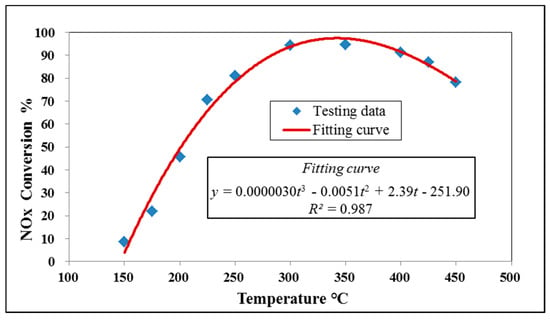
Figure 2.
NOx conversion rate of a heavy-duty truck at different temperatures. (NH3/NOx = 1, Space velocity = 20,000 h−1) [17].
In addition to the exhaust temperature, the molar ratio of the injected urea to inlet NOx (i.e., NH3/NOx ratio) and the space velocity (the reciprocal of the urea residence time in SCR system) have certain impacts on NOx conversion rate [18,19]. It requires sufficient NH3 present on the catalyst to reduce all NOx, but the excessive NH3 is discharged into the ambient air to form ammonium nitrate salts, which are important constituents of undesirable particulate matter [20,21]. Previous studies [19,22] found that when the NH3/NOx ratio is 0.8, the maximum NOx conversion rate is maintained at 50%, because NH3 is not sufficient to convert the exhaust NO to N2 through a standard reaction. The NH3/NOx ratio has little effect on conversion efficiency of NOx when the reaction temperature is lower than 250 °C [23]. As the NH3/NOx ratio increases from 1.2 to 1.4, the maximum conversion of NOx into N2 is close to 100%, and the differences of the conversion rate between them is not significant. In addition, the space velocity is determined by the measured flue gas flow and the surface volume of the catalytic reactor. For a given gas concentration, the NOx removal efficiency increases when the space velocity decreases [18].
Based on the working mechanism of the SCR system, it could be found that the urea injection strategy of Urea-SCR systems for HDDVs are designed according to ETC and ESC. It causes great differences in NOx emissions for different source types of HDDVs between the field operating modes and the typical working conditions. Deng [24] found that the NOx conversions of experimental diesel engines are 65.9% under ESC conditions and 67.8% under ETC test conditions. Wu [25] found that although the emission standard became more stringent from Euro II to Euro IV, there was no statistically significant improvement of NOx emission factors (EFs) for urban buses. Guo [26] found that the NOx emissions of Euro IV diesel transit buses are close to the emissions of Euro III. A previous study [27] found that the NOx emissions are effectively reduced in HDDTs, and the NOx emissions reduction are negligible in diesel transit buses, as shown in Figure 3.
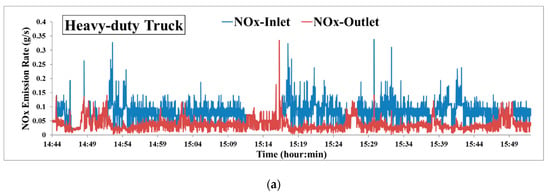
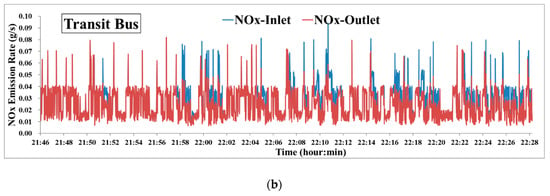
Figure 3.
The NOx emission rates from different source types of heavy-duty diesel vehicles (HDDVs) at the inlet and outlet of the selective catalytic reduction (SCR) system. (a) NOx emission rates of a heavy-duty diesel truck (HDDT) at the inlet and outlet in the SCR system. (b) NOx emission rates of a transit bus at the inlet and outlet in the SCR system. [27]
The differences of operating modes for different source types of HDDVs lead to significant variations of NOx emissions. In order to predict vehicle emissions more accurately for different source types of vehicles, many researchers have studied the field operating modes. Li [28] developed a binning method based on massive field data to improve the operating mode binning for transit buses, and the relative errors in estimating emissions using the proposed method was lower than those using the Motor Vehicle Emission Simulator (MOVES) method. Alam [29,30] observed significant differences between locally derived operating mode distributions and MOVES default distributions for the same average speeds of transit bus, and emissions derived using their locally developed operating mode distributions were improved.
The above studies indicate that there are significant variations in NOx emissions for the same operating speed or VSP under different operating modes, and the exhaust temperature is an important factor for the emission differences. However, current studies are unable to accurately evaluate NOx emissions from vehicles equipped with the SCR system based on field operating modes. The main reason is the lack of an exhaust temperature model based on field operating conditions. Therefore, the objective of this study is to establish an accurate calculation method for NOx emissions based on the temperature of the exhaust gas. It could be used to evaluate NOx emissions in different operating modes according to the real-world vehicle trajectories. In addition, the improvement measures of the SCR system are proposed in this study by optimizing the device design and adjusting the urea injection strategy.
2. Data and Methodology
In order to develop the temperature-based NOx emission models for the SCR system, the methodology includes the following steps.
- Collect the field data of vehicle trajectories, emission rates and exhaust temperatures.
- Develop the temperature model of the exhaust gas based on the VSP distributions and the temperature loss coefficient.
- Establish the accurate models for calculating the consumption of urea and NOx emission.
2.1. Data Sources
Three field data sources were used in this study, including the second-by-second vehicle activity data of transit buses and heavy-duty trucks, the NOx emissions from the HDDVs that do not have the SCR system, and the second-by-second data of the exhaust temperature. The second-by-second vehicle activity data was used to analyze NOx emission characteristics under different operating conditions according to the proposed model. The NOx emissions were used to obtain the average emission rates. The exhaust temperature was used to establish the relationship between the exhaust temperature and the VSP.
Massive vehicle activity data of HDDVs were collected in Beijing using portable GPS devices, Garmin GPS18 and Columbus V900 GPS. Over 20.5 million records of second-by-second data were collected from 2015 to 2018 by Beijing Jiaotong University.
The VSP emission rates of NOx pollutants were derived from an emission database in Beijing Jiaotong University. The vehicle emission data was collected with the PEMS instrument (Maha PEMS). A total of over 300,000 second-by-second records of NOx emissions from HDDVs without SCR systems and the corresponding vehicle speed were collected. The data collection was mainly concentrated on the following models, and the specific information of the models is shown in the Table 2.

Table 2.
Basic information of the models for emission rate data collection.
The exhaust temperature at the SCR inlet was obtained by using the on-board diagnostic (OBD) device. The data included 171,695 records of second-by-second temperature, collected from four HDDTs. The data is collected from October 27, 2017 to October 30, 2017. Details of the test vehicles are shown in the Table 3. All analyses in the manuscript were based on this type of engine.

Table 3.
Basic information on models for temperature data collection.
2.2. Emission Rate Model Based on VSP
In order to determine the inlet concentration of NOx, the NOx emission rate model was established. The average emission rates (in the unit of g/s) of transit buses and HDDTs were calculated by employing the VSP binning method. The VSP was calculated based on the instantaneous speed and acceleration, as shown in Equation (1) [31].
where,
- v = vehicle speed (m/s),
- a = vehicle acceleration (m/s2),
- A, B, C, m and f = constants that take different values according to the type of vehicles. The values of A, B, C, m and f from this study are displayed in Table 4 [32].
 Table 4. Calculation parameter values of vehicle specific power (VSP).
Table 4. Calculation parameter values of vehicle specific power (VSP).
The VSP values were classified into various bins defined by an equal interval of 1 kW/t, as shown in Equation (2). The VSP distribution, and the frequency of VSP in each bin, was obtained in every speed bin [31].
The average emission rates were calculated using the Equation (3).
where,
- average emission rates of VSP bin i,
- = measured emission value (VSP = i),
- N = the amount of data (VSP = i).
2.3. Temperature Model for Exhaust Gas Based on VSP
The exhaust temperature is the decisive factor affecting NOx emissions for vehicles equipped with the SCR system [19]. In order to accurately predict NOx emissions of HDDVs, the relationship between the field operating modes and the exhaust temperature should be analyzed. In this study, the exhaust temperature model was established according to the VSP and the heat loss coefficient, and the accuracy of the model was validated.
2.3.1. Temperature Model Development
The temperature in the SCR system was determined by two factors, including the input heat generated by the engine with the exhaust entering the SCR and the output lost heat from the SCR system. Regarding the first factor, Song [33] found that the time distribution in VSP bins can well represent the fuel consumption per unit of time. According to the law of conservation of energy, the fuel consumption is proportional to the amount of heat generated. This indicates that higher VSP values mean higher engine powers, which means more fuels burned, and further, means a higher input heat to the SCR system. Therefore, the temperature generation is a function of VSP, as shown in Equation (4). In this equation, the exhaust temperature generation is a constant when VSP is less than or equal to zero, and it is proportional to VSP when VSP is greater than zero. For the second factor, the lost heat from the SCR system is determined by the temperature difference of the physical system of the interaction and the heat transfer coefficient [34]. The vehicle speed affected the flow velocity of the air outside the device, and the rate of the heat loss is further affected. The amount of temperature lost is a function of the temperature difference and the vehicle speed, as shown in Equation (5). The exhaust temperature is a cumulative amount, which is related to the operating state of the vehicle in the previous second. Therefore, it is not possible to study the exhaust temperature of a certain moment separately. The exhaust temperature model is developed considering the temperature generation, temperature loss, and temperature in the last second, as shown in Equation (6).
where,
- = amount of temperature generation (°C),
- a, b, h and c = coefficients,
- = amount of temperature loss (°C),
- = temperature inside the SCR (°C),
- , = ambient air temperature (°C),
- v = vehicle speed (m/s),
- = exhaust temperature for the nth second (°C),
- = VSP for the nth second (if , take ),
- = exhaust temperature for the (n-1)th second (°C), and
- = vehicle speed for the nth second (m/s).
In order to calibrate the parameters a, b, h and c, the second-by-second temperature and speed data of two heavy-duty trucks were selected. There were a total of 10,023 records from 18:44 to 21:31 on October 29, 2017 for one truck, and a total of 13,519 records from 04:16 to 08:02 on October 29, 2017 for the other one. It should be noted that the ambient air temperature was not consistent due to the different collecting time, thus the ambient air temperature () was set differently for the calibration. Using MATLAB, the values of a, b, h and c were calibrated according to the genetic algorithms. In the algorithm, , and were input as independent variables, and was input as the dependent variable. The maximum evolutionary algebra of genetic algorithm was adjusted, and the parameters (a, b, h and c) were output when the coefficient of determination (R2) was greater than 90%. The results were 1.625, 0.395, 0.0135 and 0.040, respectively. The predicted temperature was compared with the field temperature, as shown in Figure 4. The predicted temperature was the result of a calculation using the temperature model established in this manuscript. The field temperature was the temperature data that was actually collected.
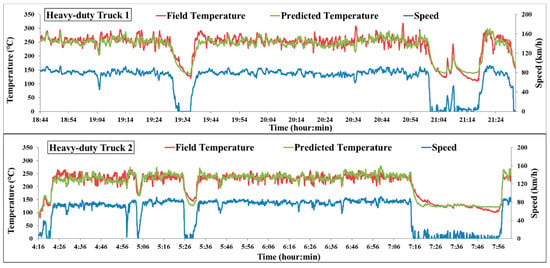
Figure 4.
Comparison between field temperature and predicted temperature.
2.3.2. Validation of Exhaust Temperature Model
Two heavy-duty trucks that were excluded in the parameter calibration were selected for the validation. The 17,765 records were selected from the first vehicle, and the second-by-second data from 17:57 to 20:52 was selected from another vehicle. Based on the correlation analysis, the predicted temperature linearly correlated with the field temperature, and the goodness of fit (R2) was 0.95 and 0.97, as shown in Figure 5. The average absolute error percentage was 5.3%. It was shown that the proposed temperature model was reasonable and reliable, and was capable of representing the real-world situation.

Figure 5.
Analysis of relationship between field temperature and predicted temperature for two vehicles (with 95% confidence intervals).
2.4. Models of NOx Emissions and Urea Consumption
The analysis of NOx emissions and the urea consumption was completed in two steps. Firstly, the reaction mechanism of urea and NOx was analyzed. Secondly, the models of NOx emissions and the urea consumption were developed based on the analysis of the emission rate model, influencing factors of NOx conversion rate and the temperature model.
2.4.1. Working Principles of Urea SCR
Commercial SCR systems employed in heavy-duty trucks are based on aqueous 32.5% urea solution, which hydrolyzes to release ammonia in the hot exhaust gas system. Urea is converted into ammonia by three steps: evaporation, decomposition and hydrolysis, as shown in the following equations [15]:
After a series of reactions, the NH3 comes into contact with the NOx and reduces it to N2 and H2O. Since NOx includes both NO and NO2, the overall reactions with NH3 are as follows [15]:
Since the NOx emissions from the diesel engine consist of approximately 90% NO and only 5–10% NO2, the reaction in Equation (10) is the predominant reaction. Ideally, about one mole of NH3 is required to remove one mole of NOx.
2.4.2. Models of NOx Emission and Urea Consumption
The models for NOx emissions and the urea consumption were established upon the NOx emission rate model and the temperature model. The NOx emission rate model was used to estimate the NOx concentration at the inlet of the SCR system under different operating modes. The relationship between the exhaust temperature and the conversion rate of NOx was defined, in which the NH3/NOx ratio and the space velocity were included. Taking the exhaust temperature as the medium, the model of the urea consumption and NOx emissions was built, as shown in the following equations.
where,
- = quantity demanded of NH3 (g/s),
- = molar mass of NH3 (g/mol),
- = molar mass of NOx (g/mol),
- = NOx emission rates (g/s),
- = NH3/NOx ratio at different temperature intervals based on standard condition (space velocity = 20,000 h−1),
- = correction coefficient of space velocity to urea injection rate,
- = correction coefficient of vehicle physical properties to urea injection rate,
- = quantity demanded of urea (g/s),
- = molar mass of urea (g/mol),
- = emission of NOx (g/s),
- = NOx conversion rate at different temperature intervals based on standard condition (NH3/NOx = 1, Space velocity = 20,000 h−1),
- = correction coefficient of NH3/NOx ratio (urea injection rate) to NOx conversion,
- = correction coefficient of space velocity to NOx conversion,
- = correction coefficient of vehicle physical properties to NOx conversion.
Three points should be noted when using the model to calculate urea consumption. Firstly, the most reasonable NH3/NOx ratio (fa) is different in different temperature intervals. According to the effect of reaction temperature on NOx conversion, the initial temperature of the urea injection is set to 180 °C. When the NH3/NOx ratio is greater than 1.2, the effect on the conversion of NOx is not significant. When the temperature is more than 300 °C, the ratio of 1.2 is the most suitable. The molar ratio of injected NH3 to the inlet NOx is 0.8, 1.0 and 1.2 respectively when the reaction temperatures are 180 °C to 220 °C, 220 °C to 300 °C and greater than 300 °C. Secondly, the coefficient of correction for space velocity (fs) is set to a standard when the space velocity is 20,000 h−1. The space velocity changed with operating modes. In this study, coefficient of correction for space velocity was 1, because of lack of data to study the relationship between vehicle operating modes and space velocity. Thirdly, correction coefficient of vehicle physical properties to urea injection rate (fp) is set based on the model of this manuscript. In this study, correction coefficient of vehicle physical properties to urea injection rate (fp) was 1.
Some points should be explained when using the model to calculate NOx emissions. The NOx conversion rate (η) is calculated according to the temperature under standard conditions [17]. The standard condition is that the vehicles in the manuscript has a state in which the space velocity is 20,000 h−1 and NH3/NOx ratio is 1. The correction coefficient of urea injection rate (Ca) is determined based on the difference in NH3/NOx ratio at different temperature ranges [22]. The values of parameters Cs and Cp are both 1.
3. Results
In order to investigate the improvement of NOx emission estimations by the proposed method, the emissions were compared to the real-world data and the estimations by the predicted model and MOVES. The MOVES method does not consider the effect of exhaust temperature on emission. The NOx emission data of five transit buses in the real-world were calculated, and the specific information of the models was shown in the Table 5. The total emissions were calculated for each trajectory using Equation (16).
where,

Table 5.
Basic information of the models for emission data collection.
- = total emission from NOx (g), and,
- = NOx emission in the mth second (g/s).
The proposed method resulted in a better performance than the MOVES method. Relative errors related to NOx emissions using the proposed method for each vehicle were reduced by 24.0%, 13.1%, 6.5%, 2.3% and 16.2%, as shown in Figure 6. The proposed method can substantially improve the accuracy of emission estimates for transit buses because the method is based on the temperature in calculating conversion rates to determine the NOx emissions. In this model, PEMS instrument (Maha PEMS) was used to collect NOx emissions from vehicles not equipped with SCR systems as NOx concentrations at the inlet of the SCR system, and an emission rate database at different VSP bins was established. The NOx emissions at the outlet of the SCR system were calculated in conjunction with the field operating data of the vehicles and the established temperature model. Therefore, the NOx emissions were calculated accurately according to the temperature model by acquiring the second-by-second speed data of a certain vehicle. However, the traditional model directly obtained the NOx emissions at the exhaust pipe outlet of vehicles equipped with SCR systems using PEMS instruments and established a database of emission rates under different VSP bins. Then, the NOx emissions of other vehicles were directly calculated based on the second-by-second speed data, regardless of the effect of temperature on emissions. Significant differences of operating conditions between the predicted vehicle and the test vehicle were observed, which resulted in the temperature variation corresponding to the same VSP. This lead to the difference in NOx emission rates and total emissions. Therefore, the traditional model leads to an inaccurate evaluation of NOx emissions from the HDDVs equipped with the SCR system.
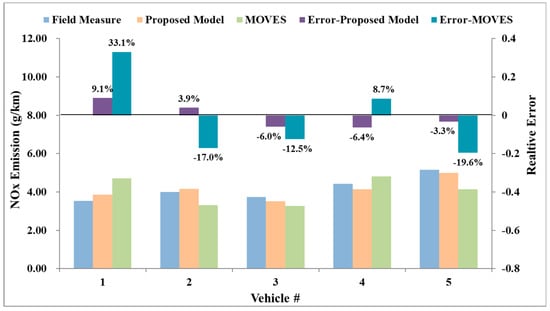
Figure 6.
Comparison of predicted, Motor Vehicle Emission Simulator (MOVES) and field NOx emission.
4. Discussion
To illustrate the impact of different operating conditions on NOx emissions, the second-by-second speed data of 14 HDDTs and six urban diesel transit buses (UDTBs) having the same engine type as above were collected. The emission rates of NOx were calculated using the model proposed in this study.
4.1. NOx Emission Characteristics of Transit Buses under Different Operating Modes
Three UDTBs were operating in the urban area, while others were operating in the suburbs. The average EFs of transit buses were grouped into speed intervals with an interval of 5 km/h, as shown in Figure 7. It was shown that the average conversion rate of NOx was 11.3% different. The average EFs of urban buses were found to be higher than the EFs of suburban buses, especially in the low-speed range. In order to reflect the impact of operating conditions on emissions, the trajectories of buses were selected for the mapping analysis. As shown in Figure 8, the idling time for buses operating in the urban area was due to the stops at intersections and stations. The exhaust temperature did not reach the minimum requirement of the urea injection. For the buses in the suburbs, the exhaust temperature was always higher than the window of the urea injection due to the short duration of the vehicle in the low-speed range.
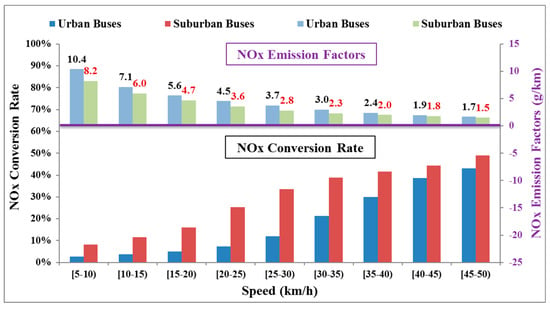
Figure 7.
Comparison of NOx emission factors for transit buses in different operating modes.
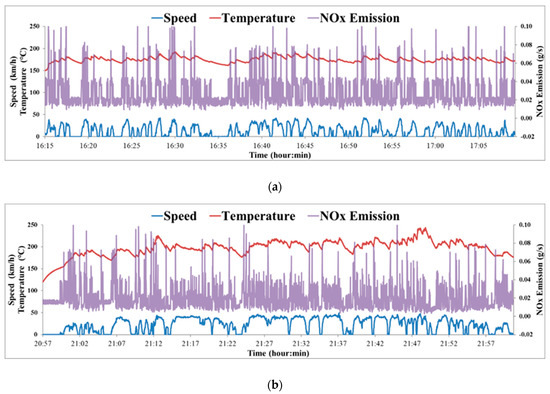
Figure 8.
Comparison of speed, temperature, NOx conversion rate and NOx emission of transit buses in different operating modes. (a) Urban transit buses; (b) Suburban transit buses.
4.2. NOx Emission Characteristics of HDDTs under Different Operating Modes
In order to analyze the NOx emission characteristics of HDDTs under different operating modes, four HDDTs operating in restricted access and others operating in unrestricted access were analyzed. The total emissions of each trajectory were grouped into speed intervals with an interval of 10 km/h, as shown in Figure 9. At the low-speed interval, the difference of average conversion rate of NOx was 13.1% under different operating modes. The average EFs of HDDTs operating in restricted access were higher than the EFs of HDDTs operating in unrestricted access. At the high-speed interval, the difference of average conversion rate of NOx was 4.2%. Then, the average EFs of HDDTs operating in restricted access were lower than the EFs of HDDTs operating in unrestricted access. In order to explain the differences, trajectories of HDDTs were studied, which are shown in Figure 10. In the low-speed interval (0–50 km/h), the acceleration and deceleration of the HDDTs operating in unrestricted access were drastic. However, the vehicles were rarely in an idle state. The residence time of the vehicle was shorter, which means a smaller drop of the exhaust temperature, and a lower NOx emission. The cold starts and long idling time of HDDTs operating in restricted access lead to higher EFs than HDDTs operating in unrestricted access. At the high-speed interval (>50 km/h), the operating conditions of the HDDTs operating in unrestricted access were unstable and the temperature fluctuation was dramatic. The HDDTs operating in the restricted access ran smoothly, and the exhaust gas was kept at a high temperature, which lead to lower NOx emissions the HDDTs operating in the unrestricted access.
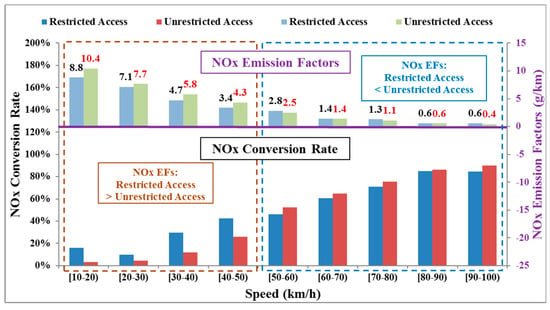
Figure 9.
Comparison of NOx emission factors of HDDTs in different operating modes.
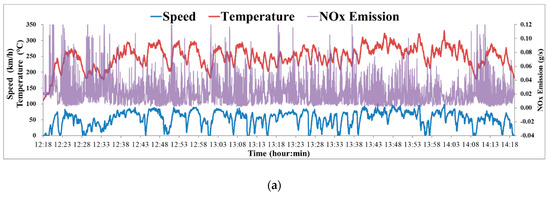
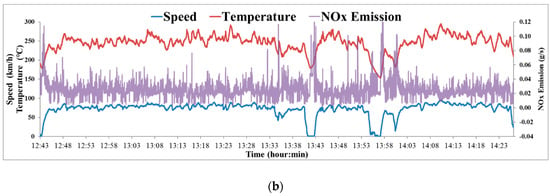
Figure 10.
Comparison of speed, temperature, NOx conversion rate and NOx emissions of HDDTs in different operating modes. (a) Operating in restricted access; (b) Operating in unrestricted access.
As shown in Figure 11, for the transit buses, the NOx conversion rate was 15.9% for the vehicles operating in urban area, while it was 40.6% for the vehicles operating in suburban area. For the HDDTs, the NOx conversion rate was 60.3% for the vehicles operating in the unrestricted access, while it was 74.6% for the vehicles operating in the restricted access. The average conversion rate of HDDTs was 39.2% higher than transit buses.
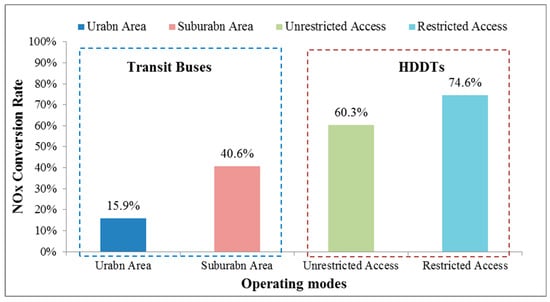
Figure 11.
Comparison of the NOx conversion rate between the transit buses and HDDTs under different operating modes.
5. Conclusions
The temperature is a critical factor for the NOx emissions of vehicles equipped with the SCR system. By using VSP as the explanatory parameter, a temperature model is proposed by modeling the input and output heat of the SCR system. Additional NOx conversion rate and NOx emission models are developed based on the temperature model. Several findings are summarized as follows:
- VSP is an appropriate parameter for modeling the temperature of the SCR system in different operating modes. The proposed model is capable of predicting the SCR temperature, in which the goodness of fit (R2) is 0.97.
- The NOx emission model established based on the temperature can accurately predict the NOx emission for different operating modes. The average relative error in estimating NOx emissions by the proposed method is 12.5% lower than those by the traditional method.
- The NOx emissions and urea injection from vehicles equipped with the SCR system show a significant variation in difference, even in the same operating modes. In this case, for transit buses, the average EFs of urban buses are higher than the EFs of suburban buses at the same speed interval. For HDDTs, the average EFs of the restricted access are higher than the unrestricted access at the low-speed interval, which are the opposite at the high-speed interval. The average conversion rate of HDDTs is 39.2% higher than transit buses.
The proposed method in this study is able to accurately predict the NOx emission. Furthermore, it might be helpful to fine tune the SCR system for different source types of vehicles. For transit buses, especially those operating in urban area, it is useful to reduce the initial temperature of the urea injection and increase the insulation material of the SCR system due to their complex and variable operating modes. For HDDTs, due to their favorable operating modes, the exhaust gas is in a high temperature state for a long time. Therefore, the injection of urea solution should be appropriately increased according to the NOx emission.
Author Contributions
Conceptualization, X.W. and G.S.; Data curation, X.W.; Formal analysis, X.W. and G.S.; Funding acquisition, G.S.; Methodology, X.W. and G.S.; Project administration, G.S.; Supervision, X.W., G.S., Y.W. and L.Y.; Validation, X.W.; Writing—original draft, X.W.; Writing—review & editing, X.W., G.S., Y.W., L.Y. and Z.Z.
Funding
This research is supported by the Natural Science Foundation of China (NSFC) #51678045, 51578052 and 71871015.
Acknowledgments
The authors would like to thank Key Laboratory of Transport Industry of Big Data Application Technologies for Comprehensive Transport for providing the emission and temperature data.
Conflicts of Interest
The authors declare no conflict of interest.
References
- He, J.; Zhong, P. Estimation of Air Pollutant Emissions from Vehicles in the Beijing-Harbin Highway. In Proceedings of the American Society of Civil Engineers 14th Cota International Conference of Transportation Professionals, Changsha, China, 4–7 July 2014. [Google Scholar]
- Twigg, M.V. Urea-SCR Technology for deNOx after Treatment of Diesel Exhausts. Johns. Matthey Technol. Rev. 2015, 59, 221–232. [Google Scholar] [CrossRef]
- Strots, V.O.; Santhanam, S.; Adelman, B.J.; Griffin, G.A.; Derybowski, E.M. Deposit formation in Urea-SCR Systems. Emissions 2009, 2, 283–289. [Google Scholar] [CrossRef]
- Ma, J.; Qu, D.; Li, J. SCR Experimental Study on Reducing NOx Emission of Diesel Engine. Appl. Mech. Mater. 2014, 644, 714–717. [Google Scholar] [CrossRef]
- Zhang, S.; Wu, Y.; Hu, J.; Huang, R.; Zhou, Y. Can Euro-V Heavy-Duty Diesel Engines, Diesel Hybrid and Alternative Fuel Technologies Mitigate NOx, Emissions? New Evidence from On-Road Tests of Buses in China. Appl. Energy 2014, 132, 118–126. [Google Scholar] [CrossRef]
- Hao, L.; Liang, Q.; Guo, J.; Ge, Y. Investigation of NOx Emissions from Euro-IV Diesel Buses Using PEMS. In Proceedings of the International Conference on Electrical, Automation and Mechanical Engineering, Hong Kong, China, 24–25 October 2015. [Google Scholar]
- Huo, H.; Yao, Z.; Zhang, Y.; Shen, X.; Zhang, Q. On-Board Measurements of Emissions from Diesel Trucks in Five Cities in China. Atmos. Environ. 2012, 32, 159–167. [Google Scholar] [CrossRef]
- Liu, F.; Shan, W.; Pan, D.; Li, T.; He, H. Selective Catalytic Reduction of NOx by NH3 for Heavy-Duty Diesel Vehicles. Chin. J. Catal. 2014, 9, 1438–1445. [Google Scholar] [CrossRef]
- Roppertz, A.; Füger, S.; Kureti, S. Investigation of Urea-SCR at Low Temperatures. Top. Catal. 2017, 60, 199–203. [Google Scholar] [CrossRef]
- Rauch, D.; Kubinski, D.; Simon, U.; Moos, R. Detection of the Ammonia Loading of a Cu Chabazite SCR Catalyst by a Radio Frequency-Based Method. Sens. Actuators B Chem. 2014, 205, 88–93. [Google Scholar] [CrossRef]
- Nova, I.; Ciardelli, C.; Tronconi, E.; Chatterjee, D.; Bandl-Konrad, B. NH3-NO/NO2, Chemistry over V-Based Catalysts and Its Role in the Mechanism of the Fast SCR Reaction. Catal. Today 2006, 114, 3–12. [Google Scholar] [CrossRef]
- Ye, J.; Gao, X.; Zhang, Y.; Wu, W.; Song, H. Effects of PbCl2, on Selective Catalytic Reduction of NO with NH3, over Vanadia-Based Catalysts. J. Hazard. Mater. 2014, 274, 270–278. [Google Scholar] [CrossRef]
- Ruggeri, M.P.; Nova, I.; Tronconi, E. Experimental and Modeling Study of the Impact of Interphase and Intraphase Diffusional Limitations on the DeNOx Efficiency of a V-Based Extruded Catalyst for NH3-SCR of Diesel Exhausts. Chem. Eng. J. 2012, 207, 57–65. [Google Scholar] [CrossRef]
- Yadav, D.; Kavaiya, A.R.; Mohan, D.; Prasad, R. Low Temperature Selective Catalytic Reduction (SCR) of NOx Emissions by Mn-Doped Cu/Al2O3 Catalysts. Bull. Chem. React. Eng. Catal. 2017, 12, 415–429. [Google Scholar] [CrossRef]
- Hsieh, M.F.; Wang, J. Development and Experimental Studies of a Control-Oriented SCR Model for a Two-Catalyst Urea-SCR System. Control Eng. Pract. 2011, 19, 409–422. [Google Scholar] [CrossRef]
- Schär, C.M.; Onder, C.H.; Geering, H.P.; Elsener, M. Control-Oriented Model of an SCR Catalytic Converter System. SAE Tech. Pap. 2004. [Google Scholar] [CrossRef]
- Feng, X.; Ge, Y.; Tan, J.; Li, J.; Zhang, Y. Effects of Electrically Heated Catalyst on the Low Temperature Performance of Vanadium-Based SCR Catalyst on Diesel Engine. SAE Tech. Pap. 2014. [Google Scholar] [CrossRef]
- Elkhalifa, E.A.; Friedrich, H.B. Oxidative Dehydrogenation of Noctane over a Vanadium–magnesium Oxide Catalyst: Influence of the gas hourly space velocity. Arab. J. Chem. 2015. [Google Scholar] [CrossRef]
- Asif, M.; Zhang, Y.; Lin, W. Urea-SCR Temperature Investigation for NOx Control of Diesel Engine. In Proceedings of the MATEC Web of Conferences, Chengdu, China, 23–34 July 2015. [Google Scholar]
- Ortega, I.K.; Kurtén, T.; Ki, H.V.; Kulmala, M. The Role of Ammonia in Sulfuric Acid Ion Induced Nucleation. Atmos. Chem. Phys. 2008, 8, 2859–2867. [Google Scholar] [CrossRef]
- Kirkby, J.; Curtius, J.; Almeida, J.; Dunne, E.; Duplissy, J. Role of Sulphuric Acid, Ammonia and Galactic Cosmic Rays in Atmospheric Aerosol Nucleation. Nature 2011, 476, 429–433. [Google Scholar] [CrossRef] [PubMed]
- Chen, C.; Tan, W. Mathematical Modeling, Optimal Design and Control of an SCR Reactor for NOx Removal. J. Taiwan Inst. Chem. Eng. 2012, 43, 409–419. [Google Scholar] [CrossRef]
- Yun, B.K.; Kim, M.Y. Modeling the Selective Catalytic Reduction of NOx by Ammonia over a Vanadia-Based Catalyst from Heavy Duty Diesel Exhaust Gases. Appl. Therm. Eng. 2013, 50, 152–158. [Google Scholar] [CrossRef]
- Deng, C.; Huang, L.; Pang, H.; Zi, X.; Li, H. Experimental Study of a HD Diesel Engine Equipped with Urea-SCR System Able to Achieve the Euro IV Emission Limits. In Proceedings of the International Conference on Remote Sensing, Nanjing, China, 24–26 June 2011. [Google Scholar]
- Wu, Y.; Zhang, S.; Li, M.; Ge, Y.S. The Challenge to NOx Emission Control for Heavy-Duty Diesel Vehicles in China. Atmos. Chem. Phys. 2012, 12, 9365–9379. [Google Scholar] [CrossRef]
- Guo, J. Research on Real-World Emission Performance of Heavy-Duty Vehicles Based on Portable Emission Measurement Systems. Ph.D. Thesis, Beijing Institute of Technology, Beijing, China, 2015. [Google Scholar]
- Beijing Municipal Commission of Transportation. Research on Data Mining and Management Application of Bus Energy Saving and Emission Reduction Based on Big Data Analysis; Beijing Municipal Commission of Transportation: Beijing, China, 2017.
- Li, C.; Yu, L.; Song, G. Improved Binning of Operating Modes in MOVES for Transit Buses: Case Study in Beijing. In Proceedings of the 96th Annual Meeting of the Transportation Research Board, Washington, DC, USA, 8–12 January 2017; January 2017. [Google Scholar]
- Alam, A.; Hatzopoulou, M. Modeling Transit Bus Emissions Using MOVES: Validation of Default Distributions and Embedded Drive Cycles with Local Data. In Proceedings of the 94th Annual Meeting of the Transportation Research Board, Washington, DC, USA, 11–15 January 2015. [Google Scholar]
- Alam, A.; Hatzopoulou, M. Embedding Locally Derived Operating Mode Distributions into the MOVES Database to Estimate Transit Bus Emissions across an Urban Network. In Proceedings of the 95th Annual Meeting of the Transportation Research Board, Washington, DC, USA, 10–14 January 2016. [Google Scholar]
- Song, G.; Yu, L.; Wu, Y. Development of Speed Correction Factors Based on Speed-Specific Vehicle-Specific Power Distributions for Urban Restricted-Access Roadways in Beijing. In Proceedings of the 93rd Annual Meeting of the Transportation Research Board, Washington, DC, USA, 12–16 January 2014. [Google Scholar]
- Song, G.; Yu, L. Characteristics of Low-Speed VSP Distributions on Urban Restricted Access Roadways in Beijing. Transp. Res. Rec. J. Transp. Res. Board 2011, 2233, 90–98. [Google Scholar] [CrossRef]
- Song, G.; Yu, L. Estimation of Fuel Efficiency of Road Traffic by Characterization of Vehicle-Specific Power and Speed Based on Floating Car Data. Transp. Res. Rec. J. Transp. Res. Board 2009, 2139, 11–20. [Google Scholar] [CrossRef]
- Davidzon, M.I. Newton’s Law of Cooling and Its Interpretation. Int. J. Heat Mass Transf. 2012, 55, 5397–5402. [Google Scholar] [CrossRef]
© 2019 by the authors. Licensee MDPI, Basel, Switzerland. This article is an open access article distributed under the terms and conditions of the Creative Commons Attribution (CC BY) license (http://creativecommons.org/licenses/by/4.0/).